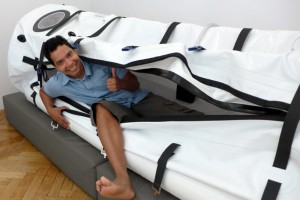The air pressure inside a hyperbaric oxygen chamber is about two and a half times higher than the normal pressure in the atmosphere. Under these conditions, your lungs can gather more oxygen than would be possible breathing pure oxygen at normal air pressure. This enables your blood to carry more oxygen to organs and tissues in your body which helps fight bacteria and other pathogens as well as stimulating the creation of new blood vessels and the release of substances called growth factors and stem cells, which promote healing. Some of the uses for Hyperbaric Oxygen Therapy (HBOT) include:
- Air or gas embolism
- Bone infections (osteomyelitis) that have not improved with other treatments
- Burns
- Carbon monoxide poisoning
- Certain types of Brain or Sinus infections
- Decompression sickness (for example, a diving injury)
- Gas gangrene
- Necrotizing soft tissue infections
- Radiation injury (for example, damage from radiation therapy for cancer)
- Skin grafts
- Wounds that have not healed with other treatments (for example, it may be used to treat a foot ulcer in someone with diabetes or very bad circulation)
This treatment may also be used to provide enough oxygen to the lung during a procedure called whole lung lavage, which is used to clean an entire lung in patients with certain medical conditions.
Treatment for chronic conditions may be repeated over days or weeks. A treatment session for more acute conditions such as decompression sickness may last longer, but may not need to be repeated.You might feel pressure in your ears while you are in the hyperbaric chamber. Your ears may pop when you get out of the chamber.
Here are links to articles from the Journal of Neuroscience and the NIH regarding other uses.
Autism: http://oxfordhbot.com/hbot-for-autism/
Brain Injury: http://thejns.org/doi/abs/10.3171/jns.1992.76.6.0929
Cancer: http://www.ncbi.nlm.nih.gov/pmc/articles/PMC3510426/
Lyme: http://hbotnova.com/resources/lyme_disease/Fife_EffectsofHyperbaricOxygenTherapyOnLymeDisease.pdf

